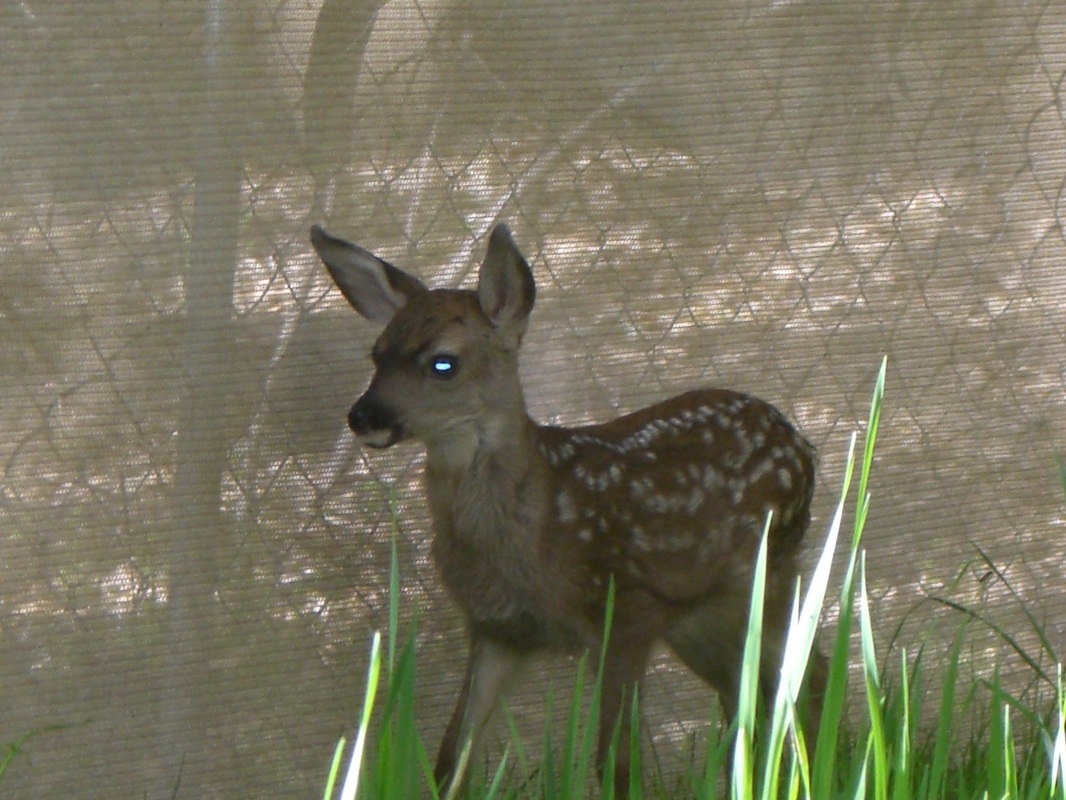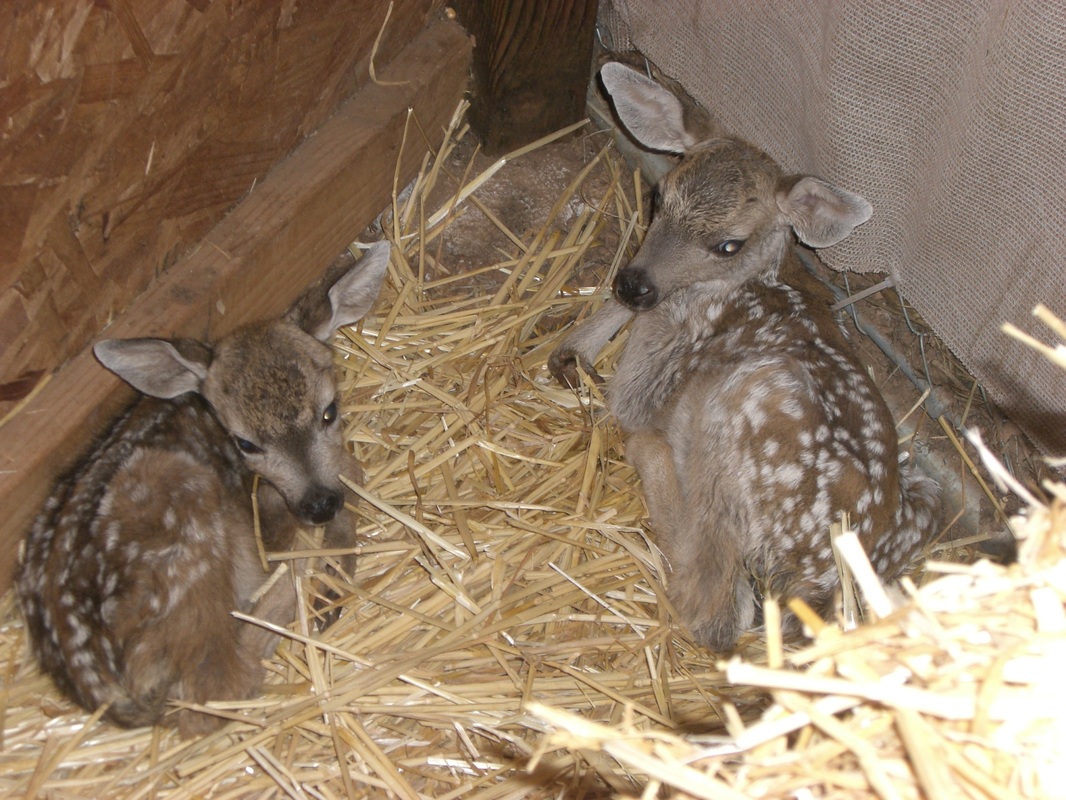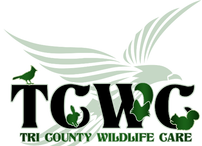From time to time, TCWC's expert rehabbers are called upon by our local news media to provide information to the community about living with our wild neighbors. This spring, Laurie Kubiak, a rehabber with nearly fifteen years of experience on the TCWC team, spoke with the Upcountry News about dealing with fawns. Here is the resulting article.
Don’t Fawn
Until they are old enough and strong enough to accompany the herd, young fawns are hidden and left alone while their mothers forage for food. If you encounter a fawn that is not in distress, leave it alone.
As spring advances, local female deer (does) will give birth to new fawns. The mating or “rutting” season usually occurs during November and early December, and fawns are usually born between late May and July, though some fawns may be born earlier.
According to Laurie Kubiak of Tri-County Wildlife Care, it is important for local residents to understand deer habits and to know what to do when encountering a young fawn.
Does often leave their fawns unattended for hours at a time. They do this in order to keep the fawn safe until it is stable enough on its legs to accompany its mother.
The doe comes back periodically, most often at dawn and dusk. They nurse and clean the fawn by licking it to remove any smells that could attract a predator.
When she leaves, the mother communicates to the fawn to stay put until she returns. After about three weeks of age, the doe will take the fawn on short outings or move it from one place to another.
Fawns weigh between four and six pounds at birth. In this area, they are black tailed deer of the Mother Lode herd. Their spots remain until approximately 78 to 83 days of age.
Deer are ruminants, meaning they are cud-chewing animals that have a specialized four-compartmented stomach. The rumen, the first stomach, receives food or cud from the esophagus, partly digests it with the aid of bacteria, and passes it to the reticulum. Fawns require a doe’s milk until they are about four months of age, when the rumen is completely developed.
As our communities continue to grow, humans encroach upon the space and the environment of wildlife.
It is not unusual for local residents to encounter a lone fawn curled up in a quiet corner or a brushy area. A common reaction is to think that the fawn has been orphaned. This is usually not the case.
“If you see a fawn or fawns alone, be sure to think about whether it or they are truly orphaned,” said Kubiak. “If it is lying alone and doesn’t seem in distress, leave it alone. If the fawn is lying in the sun, panting and seems to be in distress, move it into the shade if you are able. Put a bowl of water close by. Watch to see if the doe comes back. The most important thing to remember is to leave it alone if it is not in distress.”
Know when to leave a fawn alone, when to call for help.
Here are a few things to look for to help determine if the fawn is in distress:
If a fawn has truly been orphaned, Tri County Wildlife Care has a network of caregivers that are trained in rescue and rehabilitation. Because stress can lead to death, the caregivers provide a quiet, enclosed living area and nurture them until they are old enough and strong enough to survive.
If you find a fawn that you think has been orphaned, or if you have questions or want more information on local deer, call Tri-County Wildlife Care at 209-283-3245.
Experienced wildlife rehabilitators are available to address your concerns.
Until they are old enough and strong enough to accompany the herd, young fawns are hidden and left alone while their mothers forage for food. If you encounter a fawn that is not in distress, leave it alone.
As spring advances, local female deer (does) will give birth to new fawns. The mating or “rutting” season usually occurs during November and early December, and fawns are usually born between late May and July, though some fawns may be born earlier.
According to Laurie Kubiak of Tri-County Wildlife Care, it is important for local residents to understand deer habits and to know what to do when encountering a young fawn.
Does often leave their fawns unattended for hours at a time. They do this in order to keep the fawn safe until it is stable enough on its legs to accompany its mother.
The doe comes back periodically, most often at dawn and dusk. They nurse and clean the fawn by licking it to remove any smells that could attract a predator.
When she leaves, the mother communicates to the fawn to stay put until she returns. After about three weeks of age, the doe will take the fawn on short outings or move it from one place to another.
Fawns weigh between four and six pounds at birth. In this area, they are black tailed deer of the Mother Lode herd. Their spots remain until approximately 78 to 83 days of age.
Deer are ruminants, meaning they are cud-chewing animals that have a specialized four-compartmented stomach. The rumen, the first stomach, receives food or cud from the esophagus, partly digests it with the aid of bacteria, and passes it to the reticulum. Fawns require a doe’s milk until they are about four months of age, when the rumen is completely developed.
As our communities continue to grow, humans encroach upon the space and the environment of wildlife.
It is not unusual for local residents to encounter a lone fawn curled up in a quiet corner or a brushy area. A common reaction is to think that the fawn has been orphaned. This is usually not the case.
“If you see a fawn or fawns alone, be sure to think about whether it or they are truly orphaned,” said Kubiak. “If it is lying alone and doesn’t seem in distress, leave it alone. If the fawn is lying in the sun, panting and seems to be in distress, move it into the shade if you are able. Put a bowl of water close by. Watch to see if the doe comes back. The most important thing to remember is to leave it alone if it is not in distress.”
Know when to leave a fawn alone, when to call for help.
Here are a few things to look for to help determine if the fawn is in distress:
- Is the fawn wandering aimlessly, panting or crying? (bleating)
- Does it attempt to follow you or approach you?
- Does it appear to be injured or have you perhaps seen a doe close by that has been hit by a car?
- Is the fawn lying in the sun and seem too weak to stand up and move?
- If you are able to observe the fawns back end, does it appear to have a dirty butt? As odd as this seems, it is one of the main identifiers of a truly orphaned fawn, as does are careful to keep their babies clean and odor free to ward off any predators.
If a fawn has truly been orphaned, Tri County Wildlife Care has a network of caregivers that are trained in rescue and rehabilitation. Because stress can lead to death, the caregivers provide a quiet, enclosed living area and nurture them until they are old enough and strong enough to survive.
If you find a fawn that you think has been orphaned, or if you have questions or want more information on local deer, call Tri-County Wildlife Care at 209-283-3245.
Experienced wildlife rehabilitators are available to address your concerns.




